|
< Earlier Kibitzing · PAGE 2 OF 2 ·
Later Kibitzing> |
| Aug-17-13 | | SimonWebbsTiger: well, not <that> weird! eg Stefansson vs Radjabov, 2004 |
|
| Aug-17-13 | | luzhin: 9.Nd5! directly exploits 6...Qe8, with its attack on c7. It's an innovation from earlir this year by the Bulgarian GM Petkov. The fact that Radjabov thought for almost an hour after 9.Nd5 shows it was new to him! |
|
| Aug-17-13 | | Nerwal: This is quite curious. dxe5 followed by ♘d5 is hardly a new concept in the King's Indian : Uhlmann vs J Heissler, 1995 |
|
| Aug-17-13 | | Hesam7: <luzhin: 9.Nd5! directly exploits 6...Qe8, with its attack on c7. It's an innovation from earlir this year by the Bulgarian GM Petkov. The fact that Radjabov thought for almost an hour after 9.Nd5 shows it was new to him!> Maybe he was trying to see his way after 9...Ne4!? which more or less forces 10 Nc7 Qc6 11 Na8 Ng5 12 Ng5 h6 13 Nf3 Be6 
click for larger viewBlack is a full Rook behind but he appears to have adequate compensation: White's King is in the center, the Q-side is weak (b2 & c4) and the a8-Knight will get picked up soon. Here is an example: 14 Nd2 Na6 15 Qf3 Qf3 16 Nf3 e4 17 Nd2 Bb2 18 Rb1 Bc3 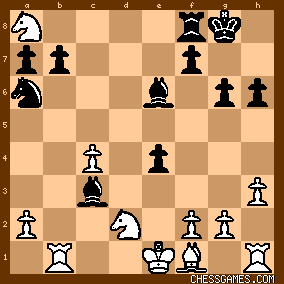
click for larger viewAnd White is still tangled, for example now 19 Rb7?? Rd8 is winning for Black. |
|
| Aug-17-13 | | Hesam7: After 9...Ne4!? 10 Nc7 Qc6 11 Na8 Ng5 12 Ng5 h6 13 Nf3 Be6 White can try to defend with 14 Qe2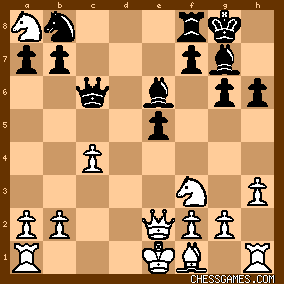
click for larger viewbut after 14...Nd7 Black should be OK, for example: 15 Rd1 Ra8 16 Qe3 Qa4!? 17 Be2 e4 18 Qe4 Nc5 19 Qe3 Bc4 20 b3 Qa5 21 Nd2 Be2 22 Qe2 Qa2 23 O-O Nb3 24 Qc4 Qd2! 
click for larger view25 Qb3 Qb2 26 Qb2 Bb2 27 Rb1 Bd4 28 Rb7

click for larger viewThis should be a draw. |
|
| Aug-17-13 | | csmath: 6. ...Qe8
You can certainly confuse me with that stuff but then again I would not gotten into this anyway. 8th and 9th moves by white are "typical" computer engine moves thus Petkov has prepared that with some Houdini machine. This is the reason why these moves are getting back in fashion - "Houdini approved". :-) This is how machine plays against KID.
Overall, this looks like a very fine tactical play by Peter and not so by Radjabov. Radjabov used to be tremendeous tactical player, what is going on with him? |
|
| Aug-17-13 | | Hesam7: <csmath: 8th and 9th moves by white are "typical" computer engine moves thus Petkov has prepared that with some Houdini machine. This is the reason why these moves are getting back in fashion - "Houdini approved". :-)> Then Black should have played 9...Ne4!?, it is definitely not an engine move and Svidler mentioned that he had no prep on it. <csmath: Overall, this looks like a very fine tactical play by Peter and not so by Radjabov. Radjabov used to be tremendeous tactical player, what is going on with him?> I got the opposite impression: Svidler outplays Radjabov based on superior knowledge of the position (after 14 ed5 the position is very similar to Gruenfeld) while playing pretty simple chess. For example he mentioned how bad the b6-Knight was and that Black had to do something to bring it back in the game. Finally from 9...Nd5 until 23 g4, when White is winning, there is very little tactics anyway. |
|
| Aug-17-13 | | csmath: Perhaps I should have just say "fine play." The position is open so I associated that with tactics. However, Radjabov made tactical oversight which is surprising to me. As a Gruenfeld player I do not associate the pattern here. The placement and development of the queenside knight is atypical for Gruenfeld as well as the center pawn opening after the exchange or the bishop on b3 being in front of the pawns. No sir, this is not a Gruenfeld pattern. |
|
| Aug-18-13 | | Everett: Nb6 for Black in the KID needs concrete back-up to be justified. Is there anything wrong with 14..Bd7 followed by ..Nc8-Nd6? |
|
| Aug-18-13 | | Hesam7: <csmath: As a Gruenfeld player I do not associate the pattern here. The placement and development of the queenside knight is atypical for Gruenfeld as well as the center pawn opening after the exchange or the bishop on b3 being in front of the pawns. No sir, this is not a Gruenfeld pattern.>
Svidler disagrees, he made the point after the game and followed it by saying that with either color he knows these positions better than Radjabov. Setting the b3-Bishop aside the pawn structure and the Knight placement are actually identical to certain fianchetto lines in Gruenfeld, see Neo-Grunfeld, 6.cd Nxd5, 7.O-O Nb6 (D76). |
|
| Aug-18-13 | | csmath: Whatever comments Svidler made are probably just a casual blab. Neo-Gruenfeld double fianchetto makes no sense here since the major threat to Radjabov is light squares bishop on b3. If you get that bishop there in Gruenfeld it will be after the b-c pawns are moved. The bishop on g2 in Neo-Gruenfeld [which I also had to face many times] is on the other side, shooting to a8. I don't remember playing or seeing Gruenfeld where knight on b8 would be going to b6. It is possible but that is atypical. That knight is needed for c5 break [which is typical of Gruenfeld] so on b6 would be doing nothing. It usually goes to c6 and sometimes to a6. By the way that knight from in Neo-Gruenfeld is not going to b6 either. By that logic everything is associated in chess games. This is not a Gruenfeld position because I would recognize it otherwise. :-)
It could be remotely similar just like it is remotely similar to any other opening where you have open center and black kingside fianchetto, whatever sense that makes. Why am I even bothering to argue that? |
|
| Aug-18-13 | | SimonWebbsTiger: http://www.chessworldcup2013.com/ne... part 3 about 54 minutes in, Svidler chats with Susan and Lawrence. "Generally speaking, we get a kind of a Gruenfeld position." (At about the 57 min. mark.) |
|
| Aug-18-13 | | csmath: "Generally speaking you get some Grunfeld-type of position." Yes, I listened that because of this silly discussion. That is a general blab designed to comfort Radjabov for losing, in my view. I means nothing except apparently to amateurs. I see also that he was remembering that he "should be playing 9. Nd5" according to his notes. Of course he did, a player of such a caliber he has surely seen 8th and 9th move of white before. I repeat this is an engine way of playing against KID so I am sure he was aware of that. If you believe he was unprepared and had not seen that before then you are really naive. Okay, I am done in this game's "discussion" with generalities. |
|
| Aug-18-13 | | BlackFront: Kramnik once divided Sicilian players into three classes: i)those who just play the opening; ii)those who feel the opening, iii)those who understand the opening. |
|
| Aug-18-13 | | Everett: <BlackFront: Kramnik once divided Sicilian players into three classes: i)those who just play the opening; ii)those who feel the opening, iii)those who understand the opening.> I would switch the order of the last two, going from worst to best. Any idea where Kramnik felt he stood? |
|
| Aug-18-13 | | BlackFront: Interview is from 1994: <The second category of adherents to the Sicilian feel this opening. I fit into this category. I have been playing the Sicilian ever since I was six, so I feel this opening. The third type of player is someone like Tseshovsky, a player who understands this opening. This is not easily attained. Except for Tseshovsky I can mention the names of Kasparov and Short....I might look at a position and have the feeling that it's slightly better for one side. I would show this position to Tseshkovsky and he would wonder why I wasn't so sure and say, 'What are you talking about? Of course it is better.> |
|
| Aug-18-13 | | Hesam7: <csmath: "Generally speaking you get some Grunfeld-type of position." Yes, I listened that because of this silly discussion. That is a general blab designed to comfort Radjabov for losing, in my view. I means nothing except apparently to amateurs.> If it was exactly like a Gruenfeld position we would call it a "transposition", it is not that but there are striking similarity, the pawn structure is identical for example ... and I do believe Svidler's experience with Gruenfeld helped him in this game. Finally if you are right and you can recognize it as "general blab", surely Radjabov can too and in that case instead of comforting it will be simply condescending. |
|
Aug-18-13
 | | perfidious: It is possible for 'amateurs' and professionals alike to learn from positions which arise from different openings-indeed, for the amateur players whom <csmath> derides, it can constitute a clear step forwards in one's conceptual thinking. Peter Svidler is one of the foremost experts on the Gruenfeld: evidently he understands much about it, though not quite enough, as <csmath> has even greater understanding. |
|
| Aug-19-13 | | notyetagm: Svidler vs Radjabov, 2013 <csmath: Perhaps I should have just say "fine play." The position is open so I associated that with tactics. <<<However, Radjabov made tactical oversight which is surprising to me.>>>> Radjabov is just having a really, really bad year. He was <2799.6> a year ago on September 2nd and now he is <2723> on the live rating list. http://www.2700chess.com
Clearly he is playing like <2650> chess this year to lose so many rating points so quickly. And like you said, here he overlooks the <PINS AGAINST UNDEFENDED PIECES> tactic 20 ... ♗g7-e5?? 21 ♖e1xe4!. |
|
| Aug-19-13 | | notyetagm: Svidler vs Radjabov, 2013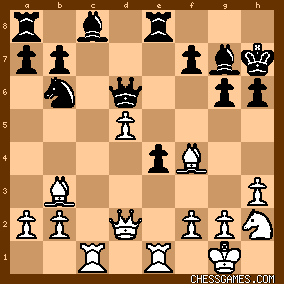
click for larger view20 ... ♗g7-e5?? <<line-closing: e8->e4@e5>
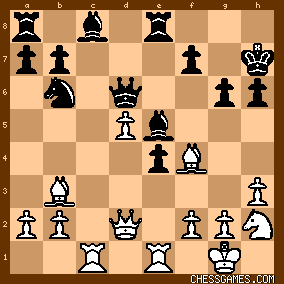
click for larger viewIn meeting the threat to his Black d6-queen by <INTERPOSING> with 20 ... ♗g7-e5??, Radjabov playing Black also <BREAKS COMMUNICATION> of the Black e8-rook which was <PROTECTING> the Black e4-pawn. 21 ♖e1xe4! <do not block your own guard lines!>
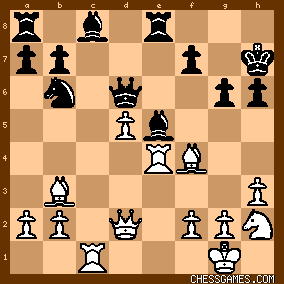
click for larger view |
|
| Aug-19-13 | | SimonWebbsTiger: @<hesam7> and <perfidious> Guess us yokels had better not believe Peter Svidler -- World class GM and Gruenfeld Expert -- when he "blabs" a position resembles a Gruenfeld 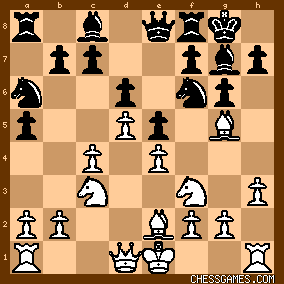
click for larger view
(a position from the Makogonov KID)
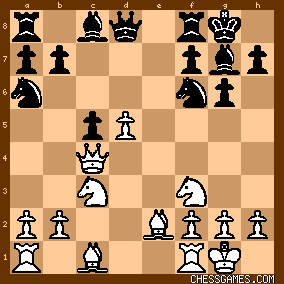
click for larger view
(a position from the Prins Gruenfeld) |
|
| Aug-19-13 | | SimonWebbsTiger: as us "amateurs" know from GM "blab", compare and contrast can be useful as a prelimenary analytical Tool. The Makogonov position given previously is Radja's bread and butter. He has played the KID for yonks. The position at move 14 in the game is possibly more usual for Svidler simply because he has battled the IQP/passed pawn on the 5th so many times in the Gruenfeld. It is not a typical Gruenfeld position; Peter explained the N on b6 wants to be at d6 but will never get there. Compare and contrast; getting a player out of his comfort zone. All in evidence. A striking example is Mamedyarov-Shoker from a previous round. Shak played 5.h4!? His opponent will never have seen this. Is it good? Compare and contrast 1. d4 Nf6 2. Bg5 Ne4 3. h4 c5 4. d5 in Julian Hodgson's favourite Tromp! Is Ng1-f3 more useful than b7-b5? 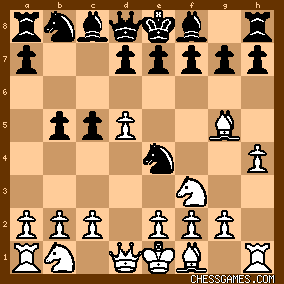
click for larger viewDepends on a <concrete> analysis. Normally Black wants to get in Qd8-b6 to eye white's weakened q-side in that Tromp line. |
|
| Aug-19-13 | | Shams: <Everett> <Any idea where Kramnik felt he stood?> We certainly know where *Kasparov* felt Kramnik stood as a Sicilian player. Remember when Big Vlad made time for a cautious ...Be7-f8 in a Sicilian game and Garry, commenting offsite, blew a gasket? Good times. I'm pretty sure it was this one. And Kasparov was probably right, of course.
Karjakin vs Kramnik, 2004 |
|
| Aug-19-13 | | Nerwal: <We certainly know where *Kasparov* felt Kramnik stood as a Sicilian player. Remember when Big Vlad made time for a cautious ...Be7-f8 in a Sicilian game and Garry, commenting offsite, blew a gasket? Good times. I'm pretty sure it was this one. And Kasparov was probably right, of course. Karjakin vs Kramnik, 2004> I would say each variation of the sicilian requires a different kind of feeling. The rules of the Dragon or the Scheveninguen are still different from the Najdorf with e5, the Paulsen/Taimanov is something else, and the Sveshnikov is also very peculiar. Obviously at this stage of his career Kramnik had no great feelings in the Najdorf (even when he tried it again in the last game of his match with Anand), while he did much better in the Rauzer in his youth, the Sveshnikov throughout his career and even 2... e6 sicilians. In that game with Karjakin a pure Najdorf player will hardly consider ♖fe8 and ♗f8 as a serious plan, it's just too slow (most likely he would rush to play b5). But of course in the Scheveninguen and Hedgehog variations, this is routine. |
|
| Aug-20-13 | | Everett: <Shams> <Nerwal> thanks to both of you. Though Watson harps on playing different openings to recognize different transposition and see different ideas, I still think that it is incredibly effective to know a system inside and out. It has worked for such luminaries as Fischer, Adams, and now Karjakin. Anand, of course is another example until just recently switching to the Q-pawn as White. Certainly his feel for the Semi-Slav is hard to match. Even amongst those supposed universalists, an astute observer will notice the superiority a player has with a particular opening. Kramnik with the Catalan, and d4 in general, is one example. We can say the same with Karpov, who practically never lost on the Black side of a Ruy until Kasparov came along. |
|
 |
|
< Earlier Kibitzing · PAGE 2 OF 2 ·
Later Kibitzing> |





